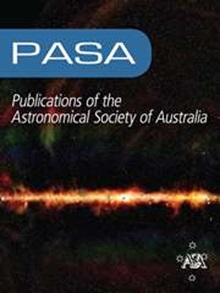宇宙午时II的Lyman-α: z ~ 2-3 Lyman断裂星系中运动学与Lyman-α的关系
IF 4.6
3区 物理与天体物理
Q1 ASTRONOMY & ASTROPHYSICS
Publications of the Astronomical Society of Australia
Pub Date : 2023-11-30
DOI:10.1017/pasa.2023.61
引用次数: 0
摘要
本文首次报道了宇宙恒星形成高峰时期恒星形成星系中星系运动学与净Lyman-α等效宽度(net Lyα EW)之间的关系。在先前报道的z ~ 2和z ~ 3处发射和吸收Lyα的Lyα- break星系(LBGs)宽带成像分离的基础上,我们使用Lyα光谱类型分类方法研究了从文献中提取的z ~ 2和z ~ 3 LBGs样品中净Lyα EWand星云发射在线运动学之间的关系,其中匹配静帧紫外光度法,一致测量净Lyα EWs,从积分场单位光谱的运动学分类是可用的。我们发现z ~ 2和z ~ 3 LBGs根据其运动学性质和Lyman-α光谱类型在色等空间中分离,并得出结论,Lyα主导吸收的LBGs (aLBGs)几乎完全是旋转主导(可能是圆盘状)系统,Lyα主导发射的LBGs (eLBGs)具有色散主导的运动学特征。我们量化了旋转动态支持强度(使用vos /2σint和vrot/σ0测量)与我们的运动学样本子集之间的关系,这些数据可用,并证明了我们的结果与其他属性的一致性,这些属性与净Lyα EWand运动学的比例。基于这些发现,我们提出了一种方法,该方法可以使用宽带成像选择旋转和色散主导的星系的大样本,只需三个过滤器和/或净Lyα EWalone。如果在更大的样本中得到证实,这种方法的应用将使我们能够在当前和未来的大面积和全天光度调查的数据集中,在大尺度上理解星系的运动行为,这些数据集将选择红移范围从z ~ 2 - 6的数亿个lbg,跨越数百到数千个Mpc。最后,我们推测,我们的结果将净Lyα EW和星云发射在线运动学与已知的Lyα-吸收和Lyα-发射LBGs的大规模聚类行为结合起来,可以联想到早期星系的涌现双峰,这与z ~ 2 - 3处的新生形态-密度关系相一致。本文章由计算机程序翻译,如有差异,请以英文原文为准。
Lyman-α at Cosmic Noon II: The relationship between kinematics and Lyman-α in z ∼ 2–3 Lyman Break Galaxies
We report for the first time a relationship between galaxy kinematics and net Lyman-α equivalent width (net Lyα EW) in star forming galaxies during the epoch of peak cosmic star formation. Building on the previously reported broadband imaging segregation of Lyα-emitting and Lyα-absorbing Lyman-break galaxies (LBGs) at z ∼ 2 (Paper I in this series) and previously at z ∼ 3, we use the Lyα spectral type classification method to study the relationship between net Lyα EWand nebular emission-line kinematics in samples of z ∼ 2 and z ∼ 3 LBGs drawn from the literature, for which matching rest-frame UV photometry, consistently measured net Lyα EWs, and kinematic classifications from integral field unit spectroscopy are available. we show that z ∼ 2 and z ∼ 3 LBGs segregate in colour-magnitude space according to their kinematic properties and Lyman-α spectral type, and conclude that LBGs with Lyα dominant in absorption (aLBGs) are almost exclusively rotation-dominated (presumably disc-like) systems, and LBGs with Lyα dominant in emission (eLBGs) characteristically have dispersion-dominated kinematics. We quantify the relationship between the strength of rotational dynamic support (as measured using v obs /2σint and v rot /σ0) and net Lyα EWfor subsets of our kinematic sample where these data are available, and demonstrate the consistency of our result with other properties that scale with net Lyα EWand kinematics. Based on these findings, we suggest a method by which large samples of rotation- and dispersion-dominated galaxies might be selected using broadband imaging in as few as three filters and/or net Lyα EWalone. If confirmed with larger samples, application of this method will enable an understanding of galaxy kinematic behaviour over large scales in datasets from current and future large-area and all-sky photometric surveys that will select hundreds of millions of LBGs in redshift ranges from z ∼ 2 – 6 across many hundreds to thousands of Mpc. Finally, we speculate that the combination of our result linking net Lyα EW and nebular emission-line kinematics with the known large-scale clustering behaviour of Lyα-absorbing and Lyα-emitting LBGs is evocative of an emergent bimodality of early galaxies that is consistent with a nascent morphology-density relation at z ∼ 2 – 3.
求助全文
通过发布文献求助,成功后即可免费获取论文全文。
去求助
来源期刊
CiteScore
5.90
自引率
9.50%
发文量
41
审稿时长
>12 weeks
期刊介绍:
Publications of the Astronomical Society of Australia (PASA) publishes new and significant research in astronomy and astrophysics. PASA covers a wide range of topics within astronomy, including multi-wavelength observations, theoretical modelling, computational astronomy and visualisation. PASA also maintains its heritage of publishing results on southern hemisphere astronomy and on astronomy with Australian facilities.
PASA publishes research papers, review papers and special series on topical issues, making use of expert international reviewers and an experienced Editorial Board. As an electronic-only journal, PASA publishes paper by paper, ensuring a rapid publication rate. There are no page charges. PASA''s Editorial Board approve a certain number of papers per year to be published Open Access without a publication fee.

 求助内容:
求助内容: 应助结果提醒方式:
应助结果提醒方式:


